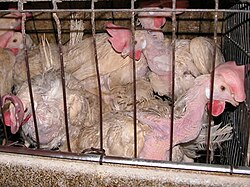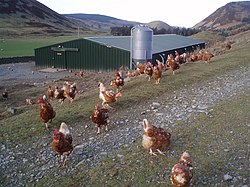動物福利
福利類型 来自维基百科,自由的百科全书
動物福利(英語:animal welfare),或譯動物福祉[1],是指非人類動物的(生活)福祉。動物福利的正式標準因環境而異,但主要由動物福利團體、立法者和學者進行辯論。[2][3]動物福利科學使用諸如壽命、疾病、免疫抑制、行為、生理和繁殖等衡量標準[4],儘管關於這些中哪些最能代表動物福利存在爭議。

對動物福利的尊重通常基於這樣一種信念,即非人類動物是有知覺的,應該考慮它們的福祉或痛苦,尤其是當它們在人類的飼養環境中。[5]這些問題可能包括動物如何被屠宰作為食物、它們如何用於科學研究、它們如何被飼養(作為寵物,或在動物園、農場、馬戲團等),以及人類活動如何影響野生物種的福祉和生存。
對動物福利概念的批評有兩種形式,來自截然相反的立場。歷史上一些思想家所持的一種觀點認為,人類對動物沒有任何責任。另一種觀點是基於動物權利的立場,即動物不應被視為財產,人類對動物的任何使用都是不可接受的。因此,一些動物權利支持者認為,更好的動物福利的觀念促進了對動物的持續和增加的剝削。[6][7]因此,一些當局將動物福利和動物權利視為兩個對立的立場。[8][9]其他人將動物福利的收益視為朝著動物權利邁進的漸進步驟。
現代神經科學領域的主要觀點是,即使在人類中也存在意識定義的哲學問題,但意識存在於非人類動物中。[10][11]然而,有些人仍然認為意識是一個哲學問題,可能永遠不會得到科學解決。[12]值得注意的是,一項新研究成功地克服了在經驗上測試這個問題的一些困難,並設計了一種獨特的方法來將動物的意識與無意識知覺分離。在恒河猴中進行的這項研究中,研究人員建立了實驗,預測與有意識與無意識感知刺激完全相反的行為結果。引人注目的是,猴子的行為表現出這些完全相反的特徵,就像在研究中測試的有意識和無意識的人類一樣。[13]
動物福利包括身體健康、自然行為的可行性(“正常行為”)和動物的情緒健康。[14]
動物福利關鍵取決於飼養者是否對動物友好,即是否滿足動物的需求。動物福利被描述為飼養環境和動物處理的可衡量標準,“環境條件在多大程度上為動物提供了避免痛苦和損害以及確保福祉的先決條件”。[15]關於哪些飼養條件和程序不被評估為動物友好的決定,取決於科學知識水平,也取決於社會偏好。立法機構定義了動物福利相關法規的最低要求。
背景
動物與人類一樣,有生理、環境、行為、心理和社群五大類需求,這些需求的滿足與否,顯示動物福利[註 1]是否良好[16]。讓動物「滿足這些需求的自由」,稱為動物福利的五大自由。
談論動物福利,得從英國皇家防止虐待動物協會(RSPCA)談起。在19世紀,英國存在鬥狗、鬥熊等殘忍的娛樂活動,也有使用殘酷方式驅趕牲畜等經濟動物[17]。1822年起,英國國會議員理查·馬丁(Richard Martin)於國會倡議設立草案[18],防止虐待[註 2]牛、馬及綿羊,其理論是要顯示人類仁愛、仁慈的行為。他於1824年更成為英國防止虐待動物協會的創辦人之一[19]。1840年,維多利亞女皇賜予該會「皇家」封號[20]。該會透過會員的捐助,募請大批調查人員,尋找出虐待[註 2]動物的人,搜集證據,並向執法機構舉報。[21]
1965年,英國政府為回應社會訴求[22],委任羅傑·布拉姆貝爾(Roger Brambell)教授對農場動物的福利事宜進行研究[23]。根據研究結果,於1967年成立農場動物福利諮詢委員會,1979年改組為農場動物福利委員會(Farm Animal Welfare Committee, FAWC),委員會提出動物都會有渴求「轉⾝、弄乾⾝體、起立、躺下和伸展四肢」的⾃由[24]。1992年,由該會提出「五大自由」的原則[25]。FAWC每年針對一種畜牧產業調查,深入研究動物福利問題,再提報告供農業部長參考。該報告會描述畜牧業的實際狀況,現存動物福利問題,與相應的原由,並提出短、中、長期的三種建議。FAWC深入溝通、攜手合作的方式十分有效,獲各國效法、類似組織接連成立。[26]
根據世界動物衛生組織《陸生動物衛生法典》(TAHC),動物福利是指,與動物生死狀況相關的生理、心理狀態,以科學為基礎,並採用五大自由推動相關福利,作為動物健康與食品安全之依據。世界動物衛生組織(OIE)於1924年成立,主要任務為制定國際貿易動物衛生標準,使世界貿易組織(WTO)有法可依。2004年,世界動物衛生組織首次召開全球動物福利會議,並在隔年出版《世界動物衛生組織動物福利標準》(OIE Standards on Animal Welfare),供會員國使用。[17]

世界動物保護協會《動物福利普世宣言》中,主要原則第3-8條:規範和管理「野生動物[註 3]」、「依人動物」、「為食物、產製品、或勞力而飼養的動物」、「同伴動物[註 4]」、「用於運動與娛樂的動物」和「科學研究中的活體動物」,其原則適用分為六類動物。在主要原則第4條依人動物(Human-dependent animals)的部分,內文重申了『五大自由』,並記載任何動物的創傷、疾病或緊迫,若嚴重到必須持續遭受痛苦時,獸醫或其他合格人士應被授權,得以人道方式讓動物死亡。[32]
動物權出自1870年代出現的反對活體解剖運動[22]。動物權(animal rights)一詞源自於動物倫理(animal ethics),相關議題探討主要涉及命題為,人類以外的動物是否享有神聖不可剝奪的權利?動物權最早並非廣泛地適對所有動物,而僅限於那些對於生理疼痛或心理痛苦有感知能力的動物,持此立場的代表性人物當屬傑瑞米·邊沁(Jeremy Bentham)。傑瑞米·邊沁是18世紀英國政治哲學家,其最常被引用的兩句話為:長有幾條腿、皮膚是否長有絨毛、是否長有尾巴,皆不能構成剝奪一個生靈享有與人類同等被對待的原因;問題不在於動物能否思考,也不在於動物能否說話,在於牠們能否感受到痛苦。[33]
動物權擁護者不滿足於避免使上述動物遭受痛苦,或為其促進福利,而希望動物固有尊嚴受到法律保障,並且具有權利主體的地位。假使完全貫徹其思想,則應該以道德方式對待動物,動物本來就享有此等權利。例如:湯姆·雷根(Tom Reagan)即主張,動物有天賦價值,動物與人有完全相同的道德地位,因此人類不能主張有更高的利益可以超越牠。其具體訴求即是廢除動物農場與動物實驗,甚至反對任何動物利用,包括養寵物。[33]
上述內容會讓人以為動物福利是西方文化獨有概念。如探討傳統佛教傳統,將發現佛教比猶太教、基督教或伊斯蘭教,更加重視對動物的關懷。在西方哲人將動物納入倫理學討論範疇之前,莊子等思想家就已經主張,愛不只存在人與人之間,且應滲透到所有眾生之間。如今中國有自己的動物權利運動推廣者,有跡象表明,他們的訴求已開始受到重視。[34]
以儒家為例,仁愛的對象不只包括人,也包含與人共生的動物。 《論語·述而》:「子釣而不綱,弋不射宿」,孔子將對待動物的態度納入仁的教化,並從中檢驗學生德行的高尚與否、寬厚與否。許多朝代的法令均能見到動物保護的影子。例如:西周頒布《伐崇令》中的「毋動六畜」,禁止傷害家畜、野生動物在內的所有動物。元朝《大扎撒》規定,任何人往躺在地上的動物身上小便將被處以刑罰。晚清時期,京師外城巡警總廳於1906年制定《管理大車規則》,其中第五條規定:「不准虐待牲口。」這是虐待一詞,首次由人延伸至動物。[35]
動物福利科學

基礎從獸醫學、畜牧學分化而來。也是獸醫、畜牧學、動物行為、心理、生理學,以及野生生物學、免疫學、神經生物學、新陳代謝學,暨社會心理學的科際整合。[22]
動物權、動物福利因為牽涉到非人類動物的道德利益,為顧及立論正確性、可信度,不能對動物感覺做擬人化(anthropomorphism)臆測,故須有實證科學,消除擬人化偏差。有鑑於此,動物福利學者特別強調研究,應從動物生理(例如:焦慮時,血液生化值的變化)、心理(痛、恐懼時,行為學的定量與定性計數)、自然(各物種的行為偏好等)三項基礎做立論根據。[36]許多人誤解金魚只有三秒記憶,科學家如何評估水生動物的智能、情感與痛苦呢?國立中山大學生命科學系副教授顏聖紘表示,許多研究早指出魚類具有高度智能、學習能力,有些類群甚至比陸生動物還要傑出,部分魚類證實有自我認知、工具使用,有社群生活與社會結構。他認為,人們對待動物與食物的方式不同,只是取決對牠的偏見與偏愛,這根本不是科學知識,而是人的問題。[37]
- 〈人類與動物關係學(Anthrozoos)〉[22]
- 〈動物福利(Animal Welfare)〉[22]
- 〈動物與社會(Society & Animals)〉[22]
- 〈應用動物福利科學(Journal of Applied Animal Welfare Science)〉[22]
雪梨大學博士生亞歷山德拉·格林在《科學報告(Scientific Reports)》發表了一篇論文,證實乳牛發出聲音有其意義。格林的指導教授 Cameron Clark 表示,此研究具有啓發性,可創建屬於牛的Google翻譯。格林表示:「我們希望通過了解這些聲音,農民能夠調適牛的情緒狀態,藉此改善動物福利。通過了解這些聲音特徵,農民就可以識別出牛群中,可能需要特別注意的動物。」而研究最後也呼籲農民將有關乳牛聲音的知識納入日常飼養方式。[38]
亞歷山德拉歷經5個月、數百小時的時間,使用麥克風記錄18頭荷尔斯泰因牛(Holstein-Friesian)的聲音,共採集到333個聲音樣本,再前往法國圣艾蒂安(Saint-Etienne)與生物聲學家 David Reby 與 Livio Favaro 合作,藉以分析聲音特徵,進一步比較不同乳牛語句結構的差異。研究主要設定了5種情境,分別是:『發情期』、『等待飼料前』、『被拒絕餵食』、『被迫與其他牛群隔開』、『與其他牛群隔開且無法看見對方』;前2種情境被歸類為「正面情緒(Positively valenced)」;後3種則是「負面情緒(Negatively valenced)」。結果顯示,乳牛的聲音表現在上述情境皆屬穩定,並可展現興奮、激勵、求歡或苦惱……等情緒,以便與其他牛群保持聯繫。[38]
動物福利問題
動物園的展示動物,通常在人造空間內被終身囚禁,導致動物福利議題經常被討論[39]。為解決問題,動物園的現代管理者就必須設出計符合人道、豐富化的設施與飼養方式。[40]
現代畜牧業起源於19世紀後半,工業革命造就人潮向都市集中,為供應都會區食物,農產品生產開始改善效率。在歐美地區,首先計畫選育高生產效率的家畜、家禽品種[註 5],譬如:荷蘭乳牛、丹麥的藍瑞斯豬、英國的安格斯肉牛、義大利的來航蛋雞、美國的洛島紅(蛋肉兼用雞)……等,比傳統品種更良好的生產效率。以肉雞為例,一隻雞出售體重要達到3斤,早先的飼養期要半年以上;20世紀誕生的洛島紅只需3個月,當時剛利用雜交生產的白肉雞2個月便可出售,改良到現在,體重僅35天就能達到3斤半[註 6]。現代畜牧業使動物生活在狹小空間、密集飼養,導致互相傷害,最簡單方法就是將雞剪喙控制啄羽,仔豬斷尾以防止咬尾巴,殘害動物肢體變為業界例行公事。禽畜產品價格便宜,一旦生病,農場主不會聘請獸醫[註 7],因為不敷成本。[26]
歐盟衛生和食品安全專員 Janusz Wojciechowski 表示,歐盟即將出版《從農場到餐桌》戰略計畫,其中一項重點就是動物福利標章。歐盟執委會表明將修訂動物福利法案,其中包含更嚴格管制動物運輸,使法案更全面、易執行,並實踐更高水準的動物福利。因應德國代表團呼籲建立一個透明、統一的全歐盟動物福利標章,歐盟也正在研擬相關措施,希望藉此讓消費者安心。歐洲地區有許多企業或NGO正推行自家版本的動物福利標章。例如:法國 ÉtiquetteBien-Être 動物福利標章就被大力推行,該標章由四個動保協會(LFDA、CIWF、Oaba 和 Welfarm)與超市零售商 Casino、家禽生產商 Fermiers de Loue 與 Fermiers du Sud-Ouest 三方共同合作,最近被家樂福超市、Systeme U 零售公司、家禽品牌 Galliance 和農業合作社 Terrena 採用。發表在《食欲》(Appetite)雜誌上的一項澳洲研究就證實,這項計畫確實影響消費者的購買意願,雪梨大學獸醫學院 Amelia Rose Cornish 總共訪問1千多名民眾、調查消費者喜好,發現提供標章等額外資訊,大幅增加人們購買福利產品的意願(與傳統福利產品相比)。研究人員還發現,這些標章還能提高民眾對「動物福利」的觀感及認識。[41]
集約飼養[註 11]為了大量廉價的肉食,繁殖、飼養越來越多農場動物,導致土地、水及大氣層,皆承受著巨大威脅[註 12]。以工廠化飼養,不只消耗水與穀物過多,也排放污水、溫室氣體[46],並耗損草地[註 13]。動物福利被嚴重剝削,動物健康也難以維持,為了防止疾病減少損失,大量動物用藥也導致人類的健康風險。世界衛生組織就指出:人類60%疾病都與動物疾病有關,而在這些年出現的新型疾病中,這一比例更是高達75%。[47]環境髒亂、空間狹小、限位飼養、漏縫地板……等,集約化養豬中常見問題使豬隻生理、行為異常,導致降低免疫力,個體對各種病原菌極度敏感,進而大量使用疫苗、抗生素等藥物,增加生產管理成本,影響動物食品安全。[48]動物社會研究會主任陳玉敏表示:「蛋雞最容易發生的疾病例如球蟲,蛋農就會在飼料裡添加很多藥物,很多藥物都會被驗出藥物殘留,很多雞蛋告訴我們沒有藥物殘留,但是我們要問到底檢測幾項?檢測的值在哪裡?雞活的非常痛苦的時候,所產出的蛋絕對會受到影響。」[49]
禽畜集約飼養為達最低生產成本,未考慮動物福利。對福利的任何改善皆使成本提升,由消費者承受價格波動。從事畜牧、獸醫的工作者都應了解動物福利的概念,他們需認識密集生產的經營模式已嚴重傷害動物,且此情況受到全世界關注。農場動物福祉需要畜牧業者親身面對,瞭解動物生理、行為,知曉動物福祉是否受損,熟悉畜牧作業才知受損原因,進而研發有效的改善方案。市面上針對中小學生的動物福利教材,許多會介紹觀念與如何對待動物,也指責非人道對待動物的畜牧業者,只是讓社會大眾更不能諒解,使業者反感,對改善福利沒有幫助;卻少提到貪得便宜、浪費食物才是主因,而畜牧業也是被害者。[26]
1988年,瑞典廢除母豬狹欄[50]後,英國、芬蘭、瑞士、荷蘭、歐盟、加拿大、紐西蘭、澳洲、南非、美國部分州隨後跟進,修法限制使用,淘汰「狹欄[51]」漸成大勢。歐盟食品安全局(EFSA)2007年的報告更指出:母豬會因狹欄限制其行動而有緊迫、沮喪與不正常的站立、躺臥等現象[52]。歐盟在2013年規定[53],母豬只能在配種後四週,分娩前一週進入狹欄;其餘時間必須給予充足的活動空間,採「群養[51]」方式,增加與同伴互動頻率。英國規定更嚴,除了分娩前1週,仔豬離乳當天除外,皆必須進行群養。[54]母猪直接影响到仔猪的成活率,母猪的异常母性行为导致仔猪被咬死、踩死、压死。现代养猪生产只重视降低挤压、导致仔猪死亡,卻忽视母性对降低仔猪死亡率的作用。母性行为受多因素,如:激素、环境、遗传等方面影响和调控的复杂过程。[55]
根據民調公司Welfare Quality Network調查,絕大多數歐洲消費者,如荷蘭人有69%、英國人73%、法國人75%、挪威人84%和義大利的87%都認為農場動物的福利很重要,但這些人被問到相關內涵時,卻一無所知。[41]以雞蛋為例,在衡量過利益與傷害後,消費者可以支持少消費(足夠就好)的原則外,尚能選擇支持自由放牧的雞蛋及相關產品,確保農畜產品是維護良好的動物福利而生產。[47]歐盟在法令上的進步已領先許多國家,例如:2012年禁止格子籠[註 8]飼養。像是德國、荷蘭、法國的雞蛋上有編號,只看首位數字便知雞蛋生產是否符合動物福利。他們將雞蛋分成4級:編號「0」是指母雞完全在自然環境下生長,自由地在農場進出,享用大自然的食物,沒有施打生長激素。編號「1」也是放牧[註 9]飼養,自由走動,並非餵有機食物。編號「2」為室內平飼[註 10],可在地板走動。編號「3」飼養在籠子裡的母雞,無法自由活動。[56]《米其林指南》則分類成五種:室內平飼雞蛋(Barn-laid Eggs)、非籠飼雞蛋(The Cage Free Egg)、放牧雞蛋 (Free Range Eggs)、放養雞蛋(Pastured Egg)、格子籠雞蛋(Battery Farmed Eggs)。[57]
英國皇家防止虐待動物協會委託蘇格蘭農業學院(SRUC)的一項調查顯示,高福利、慢速生長的雞,死亡率、淘汰率較成長快速的品種顯著更低。該研究比對4個品種的白肉雞,其中3種為全球廣泛使用、生長速度快速的品種,分別是:科寶(Cobb 5005)、哈伯德(Hubbard Flex)與樂斯(Ross 308),剩下是商業上可行、生長較緩慢的一種雞。SRUC針對健康情況、福利標準、肉質做評比,結果顯示成長較快的品種,其死亡率、肉質、發生木質化胸肌[註 14]的機率都比慢速生長來得高。研究結果顯示,49%生長速度較快的會面臨死亡或淘汰風險,而慢速只有16%。因為生長速度較快的雞體重可以快速增加,但腿部肌肉、骨骼可能發育不完全、胸部羽毛也還沒長齊,不斷壓迫下容易出現健康問題,發生關節灼傷、足墊皮膚炎[58]、雞胸囊腫……等病症。高達78%的快速成長雞,肉質因脂肪沉積形成白條紋[59],使肉質口感變得較老、較柴;相對慢速雞只有10%呈現這種情況。還有一種木質化胸肌[註 14]也會影響肉質,在快速成長雞中有23%出現此症狀,而慢速雞只有1%。[60]
RSCPA 雞隻動物福利專家凱特·帕克斯(Kate Parkes)指出,這項新的獨立研究表明,常規生產的肉雞非常浪費,由於死亡率增加、雞隻也容易因腿部等健康狀況被淘汰,農民會面臨雞群近一半的損失。近年來,歐美國家以非常快的速度發展動物福利運動,在爭取肉雞福祉方面,2017年就出現28家跨國動物保護組織聯合發起《歐洲肉雞承諾》(European Chicken Commitment)[61],要求超市、連鎖餐館店和酒店集團共同簽署,2026年前提高整個雞肉供應鏈的福利標準。美國最早的雞肉生產商 Bell&Evans 也曾承諾會在2018年底將全數換為慢速成長、有更高福利標準的品種[62]。不過,傳統認為提升經濟動物福利勢必會減少獲利、讓農民虧損。[60]

近年歐美不少著名廚師發起運動,關注入廚的肉類,是否來自被良好對待的動物,因為他們認為動物生前受到較好的對待,製作出來的食物的質素也會好一些。[63]以美國 USDA 及法國 Labelrouge 等,標榜高價與優質畜產品之認證系統對畜牧生產之管制為例,其中對於禽畜生長條件、人道管理與對待有著極高的要求,而主要的原因即在於人道之管理方式,可以提升畜產品品質。以豬隻飼養來說,提供豬隻充足的空間與豐富之環境,可以使豬隻生長體型較一般飼養之同齡豬隻大,而且可以因此增加豬肉之多汁性。[64]
屠宰前的緊迫,會使肌肉產生代謝,致最終屠肉品質受影響,屠前緊迫容易產生水樣肉(PSE)及暗乾肉(DFD),PSE肉與屠前急性緊迫有關,DFD肉則跟慢性緊迫、哀竭相關;無論PSE或DFD均不受消費者喜歡,不適宜肉品加工。運輸裝載密度牽涉到動物福利與豬肉品質,當密度超過200公斤/m2時,即使短距離也提高心跳速率。空間不足豬隻無法躺臥,長時間站立消耗過多儲存能量,引發PSE;但密度過於寬鬆,導致豬體因剎車或行駛起步引起的搖晃,衝撞車內護欄而受傷。[65]人道屠宰的最基本要求:宰殺動物前,先將動物「致昏」、失去痛覺,再放血,使其死亡。科學研究豬與牛的生理、神經系統,從有效刺喉放血到腦反應停止的時間最長是22秒,而動物電昏後恢復意識至少需37秒的時間;因此刺喉放血必須要在致昏後15秒內完成,確保動物在屠宰期間保持無感狀態,減少痛苦,以提升動物福利。廣義的人道屠宰,包括經濟動物的人道運輸、裝卸載;合乎豬隻行為的繫留環境、走道以及驅趕方式;以儘量減少動物的緊迫與恐懼。[47]荷蘭下議院通過一條具爭議性的法律規定,猶太人、伊斯蘭教團體在一年內,必須證明傳統方式宰殺所遭受到的痛苦,並不會超過先被電昏後宰殺的動物。如果人民無法提出證據,則此後荷蘭境內都須遵守先電昏後宰殺的程序。[34]
「根據一位巴黎的米其林三星主廚說法,使用日式宰殺法(活締[註 15])處理的魚,可以放一星期,但在法國,同樣的魚只能保持兩到三天。」移民法國的日籍美食家增井千尋在《魚料理:一種日本藝術》中寫到。[66]海洋大學食品科學系副教授蕭心怡說明,水生動物福利與水產食品品質的關聯,魚類死後進入僵直期[註 16],肌肉失去伸展性、彈性。蕭心怡指出,僵直是重要的判斷準則,擁擠環境下,魚死後僵直速度較快,pH值下降也比不擁擠來得迅速。因此魚死前,掙扎越少越好,最好一捕獲馬上屠宰、進冷鏈。消費者會有魚冷凍起來較不新鮮、買魚時要選在動的的迷思,其實魚死得較慢,會導致乳酸生成、pH值下降。讓活魚產生越多緊迫,越不利於運儲保存。蕭心怡解釋,使用窒息法、CO2麻醉法、電擊法進行屠宰,都會使魚類不斷掙扎,這會讓魚肉質地較軟,處理魚片時容易碎掉而影響品質,消費者普遍不喜歡。從消費者對品質的要求,機械敲擊法是最佳屠宰方式,能讓僵直較晚發生,魚肉也有較高的水含量。唯獨人工執行時,需仰賴執行者能力、訓練及身心狀態;採用自動化又受限於體型大小不一,較難應用在小型魚類上。[67]
台灣漁業經濟發展協會秘書長陳詩璋表示,全球良好農業規範(GLOBAL G.A.P.)為當前相關標章中,唯一將動物福利納入水產加工流程(CoC)標準的驗證標章,重視魚隻運輸時的條件、捕撈時的健康情形、擊昏與放血過程等環節。GLOBAL G.A.P.內提到,魚隻屠宰時應關注外觀健康指標,是否損失魚鱗、魚鰭腐爛、遭咬傷或寄生蟲病害等。將魚搬運時,應定期監測狀況,例如:密度和溶氧條件,避免魚受到不必要的緊迫。捕撈人員都要接受屠宰照護訓練,包括:擊昏與放血等技巧的特別訓練,以有效的擊昏方式,確保魚隻都能立即失去意識。[37]
華人社會普遍有「吃活魚」習慣,水產品選購偏好鮮活狀態,因此在倡議水生動物福利時,造成產業面和消費端的矛盾。主婦聯盟生活消費合作社代表認為:「最有影響力的就是消費者,透過消費者力量就可以帶動生產端改變。」家樂福連鎖通路業者更表示:「其實賣活魚是很麻煩的,需要很多配套,包含收成、運輸、以及維持銷售時的最佳樣貌。」漁業署副署長林國平針對活綁鱸魚(弓魚)[68],他強調:「這是非常殘忍的,儘管它是有百年歷史的傳統習俗,但這是不好的,我們可以將該技術保存、但還是要讓弓魚成為歷史。」林國平也坦言,有時是運送業者或是市場販售端綁魚(弓魚),不能全怪實際的養殖者,而漁業署未來將從消費端教育著手,宣導正確食魚文化。[37]
立法
當前全球漁業都面臨天然資源下降、漁獲量減少的問題,唯獨養殖漁業的比例提高、產量上升,因此國際間越來越重視養殖漁業的飼養方式,以及魚是否受到良好的福利對待。時至今日,水生動物福利在執行上仍有諸多難處,產業端和消費市場也尚未達成共識。台灣動物社會研究會坦言:「當面對魚類等水生動福問題時,與過去討論哺乳動物的動福議題,社會有著很不同的迴響。」雖然魚類屬於脊椎動物,但大眾普遍對其較不了解,讓水生動物福利的推展進度相對緩慢。世界動物衛生組織(OIE)《水生動物健康法典》(Aquatic Animal Health Code)[69]明定魚類、兩生類、甲殼類與軟體動物……等,應皆受動物福利保障,改善魚的福利,甚至能增加產能、更提升經濟效益。[37]
主要法規為美國農業部《動物福利法》(Animal Welfare Act, 2013)[70],規範動物為鳥類、哺乳類為主,不包含變溫動物,USDA 於 2003 年發布《鱼类福利信息资源》(Information resource on Fish Welfare)[71](包含其他水生無脊椎動物)之動物福利論述與文獻資源整理。並於官網上發布實驗用水生動物,如非洲爪蟾(水生蛙)、斑馬魚與其他動物的動物福利指標。兩生類與魚類尚未被納入《動物福利法》中,因此違反動物福利的行為尚未有罰則。
主要法規為《動物護理與保護法》(Animal Care and Protection Act, 2001)[72],規範動物為所有脊椎動物與頭足類動物,遵循準則為世界動物衛生組織、世界動物保護組織以及歐盟的《福利品質》(Welfare Quality)[73]。澳洲聯邦法律訂有《澳大利亞動物福利標準與準則》(Australian Animal Welafre Standards and Guidelines)[74]。但各省步調並不一致,僅昆士蘭、塔斯馬尼亞、維多利亞,以及新南威爾斯省的法律將魚類納入動物福利法規管理。然而澳洲對於可被飼養之本土物種與外來觀賞物種的規範相當嚴格,所以其管理方式是嚴格控管外來觀賞物種輸入,對於動物福利規範的執行強度則較低。
主要法規為《動物愛護管理法》[75],規範動物為所有被人飼養之動物;兩生類與魚類原本不在法規範圍內,於 2011 年被檢討建議納入,並強調棄養觀賞魚對環境生態造成的影響。受到規範的對象不僅只有一般業者,還包含公私立水族館、動物園等機構,惟仍處於勸導方式。2013年9月1日,日本《动物爱护管理法》进行修正案起开始实行。该法案限制了对出生不久的幼猫幼犬的销售行为,并规定出售宠物时有义务对买主进行当面说明等。[76]2016年4月,东京都墨田区的“猫爪”猫咖啡成为日本首家基于《动物爱护管理法》遭到停业30天行政处分的猫咖啡。[77]
主要法規為環境部 《動物福利法》(Animal Welfare Act, 2006)[78],規範動物為所有非人類之脊椎動物,觀賞魚、兩生類、爬蟲類的運輸、販賣、展示都被規範,但是觀賞魚並不受到養殖魚類(farmed fish)條款的限制。《動物福利法》對部分動物(例如狗、經濟性畜產動物)訂有特別條款,並非所有的條文皆適用所有的脊椎動物。然蘇格蘭、英格蘭、威爾斯與北愛爾蘭另有地區性適用條款。英國執法嚴格,且非常有效率。BBC 或 Dailymail 經常有違反法律而被吊銷執照的店家或被判刑(或勞動服務)的事件報導。
歐盟《Council Directive98/58/EC》[79]規範所有繁殖或養殖動物之最低標準,亦涵蓋利用於食用、休閒娛樂與寵物飼養之魚類對象。
2020年3月31日,广东省13届人大常委会第19次会议表决通过《广东省野生动物保护管理条例》[80],条例于5月1日起施行。同日,《深圳经济特区全面禁止食用野生动物条例》[81]在市六届人大常委会第40次会议第2次全体会议上表决通过。[82]中國農業農村部公布《國家畜禽遺傳資源目錄》,並徵求意見稿,名單明列31種可食用動物;其中狗被特化為「伴侶動物」,不宜列入畜禽管理。[83]動保團體長久以來關注每年6月在廣西舉辦的玉林狗肉節,食用狗肉爭議不斷,礙於飲食文化難以禁絕。[84]
1998年發佈《動物保護法》[85][86],動物福利為該法的主要法源依據[87]。2019年9月[88],台灣出版《動物福利白皮書》[89]。該白皮書以三大面向為基礎,訂定七項策略方向。[90]
國立成功大學法律系王毓正教授指出,目前與動物保護相關法律分為:《動物保護法》、《野生動物保育法》兩部分。法律將動物分別為兩類,一類是人為飼養、管理的犬、貓與其他脊椎動物;另一類則是非人為飼養、管理的野生動物。《動物保護法》甚至又把動物分成寵物、經濟動物、實驗動物,寵物獲得《動物保護法》最高度的保障,而經濟動物在《動物保護法》裡則幾乎沒有特別保障。[91]
根據1935年港英時期訂立的第169章《防止殘酷對待動物條例》[92],殘酷對待動物行為包括殘酷地打、踢、惡待、折磨、激怒或驚嚇動物,或因胡亂或不合理地作出或不作出某種作為而導致任何動物受到任何不必要的痛苦。 一經定罪,最高可處罰款$200,000及監禁3年。[93][94]
2016年9月1日,第4/2016號法律《動物保護法》施行,明令禁止殘酷對待動物的行為,違者需要負上刑事責任。[95][96]
《2015年動物福利法令》規定,任何人若虐待動物,或不是在例外的情況下殺害動物,均屬違法,違者可被判處監禁或罰款,或是二者兼施。[97][98]
註釋
参考文献
外部链接
参见
Wikiwand - on
Seamless Wikipedia browsing. On steroids.



